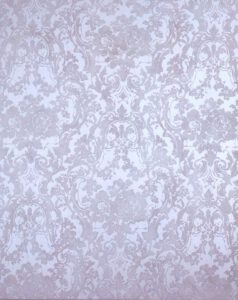
Rudolf Stingel grew up in the Italian Tyrol, where he became familiar with historical art styles such as the Rococo and Baroque. He studied at the Vienna Academy, which is known for its particular focus on decorative woodcarving. Stingel expressly incorporated these elements into his later work, as in this untitled painting from 2009. What at first sight appears to be a repetitive wallpaper decor, turns out to include small irregular and unpredictable patterns. Stingel uses these nuances to encourage the viewer to look more closely and reflect on reality and perception.
NL
Rudolf Stingel groeide op in het Italiaanse Tirol waar hij vertrouwd raakte met historische kunststijlen als de rococo en barok. Hij studeerde aan de Weense academie die bekend staat om haar focus op decoratief houtsnijwerk. Die elementen verwerkte Stingel nadrukkelijk in zijn latere oeuvre, zoals in dit titelloze schilderij uit 2009. Wat zich hier op het eerste gezicht voordoet als een repetitief behangdecor, blijkt bij een tweede aanblik kleine onregelmatige en onvoorspelbare patronen te omvatten. Met deze nuances wil Stingel de toeschouwer aansporen om beter te kijken en te reflecteren over werkelijkheid en perceptie.
FR
Rudolf Stingel a grandi dans la partie Italienne du Tirol, où il s’est familiarisé avec des styles artistiques historiques tels que le rococo et le baroque. À l’Académie de Vienne, il s’est concentré sur la sculpture sur bois décorative, qui fait la réputation de l’institution. Stingel a délibérément exploité ces éléments dans ses dernières œuvres, comme la présente peinture sans titre de 2009. Ce qui à première vue passe pour un décor de papier peint répétitif s’avère, en y regardant de plus près, comprendre de petits motifs irréguliers et imprévisibles. C’est à travers ces nuances que Stinger entend encourager le spectateur à aiguiser son regard et à réfléchir sur la réalité de la perception.